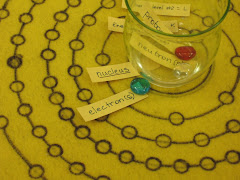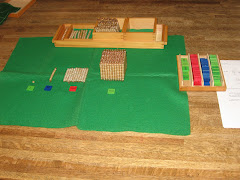Last week I prepared and presented a geometry lesson to many of my students as an introduction to lines. This is quite a fun one to present, and clarifies concepts that appear to children as abstract mysteries on paper (but don’t all Montessori lessons do just that?). I had to look back into my notes and photos from my training. I am still not sure I replicated the presentation exactly as my instructor did it, but am hoping I did justice.
I prepared a tray with a clear container filled half-way with water, a tongue depressor, scissors, a ball of yarn, a homemade plumb line (a pencil with thread tied to the top, and the thread is weighted down by something – in this case a binder clip), two paper arrows, and the following labels: line, ray, line segment, origin, vertical, horizontal.
I demonstrated each step of the presentation to the children, and then provided them with the steps so they could replicate the presentation and, hopefully by doing so, gain thorough understanding of the concepts.
 The tray was available on the shelf for the students to recreate the presentation and complete the follow-up activities.
|  Here are the steps the students followed to do the presentation themselves. Here are the steps the students followed to do the presentation themselves.
|
 Step 1: Unravel ball of yarn the length of your arms, and tell children that this goes on and on forever in both directions. Tell them, “This is a line” (I did not place the labels until the end.) Step 1: Unravel ball of yarn the length of your arms, and tell children that this goes on and on forever in both directions. Tell them, “This is a line” (I did not place the labels until the end.)
|  Step 2: Cut the yarn near the ball, and place the arrow on the other end to show it continues on forever in the other direction. Tell the children “When I cut the yarn, it still continues on forever in the other direction. But now that I cut it, it begins here, it has an origin – a beginning. This is called a ‘ray’.” Step 2: Cut the yarn near the ball, and place the arrow on the other end to show it continues on forever in the other direction. Tell the children “When I cut the yarn, it still continues on forever in the other direction. But now that I cut it, it begins here, it has an origin – a beginning. This is called a ‘ray’.”
|
 Step 3: Say to the children, “now if I cut the other end (cut the yarn at this point and continue holding both ends of the yarn), it does not continue on forever. It stops – it has two ends, or two points. This is called a ‘line segment’.” Step 3: Say to the children, “now if I cut the other end (cut the yarn at this point and continue holding both ends of the yarn), it does not continue on forever. It stops – it has two ends, or two points. This is called a ‘line segment’.”
Step 4: Now you can cut pieces and label each one. You can also cut another piece of yarn, make it curved and tell them that is a curved line.
|  Step 5: Place tongue depressor in the water and show the students. Then tilt the container and ask them what they observe about the tongue depressor and the water. Tell them this is “horizontal”. Ask them if they know what the horizon is and then describe it if they do not know. Ask them to find things in the room that are horizontal. Step 5: Place tongue depressor in the water and show the students. Then tilt the container and ask them what they observe about the tongue depressor and the water. Tell them this is “horizontal”. Ask them if they know what the horizon is and then describe it if they do not know. Ask them to find things in the room that are horizontal.
|
 Step 6: Take the plumb line from the tray and ask them if they know what a plumb line is. Describe the idea of a plumb line and what it is used for (namely in construction and the like, to make sure things are straight up and down or vertical). Tell them to look at the thread, tell them this is “vertical". Step 6: Take the plumb line from the tray and ask them if they know what a plumb line is. Describe the idea of a plumb line and what it is used for (namely in construction and the like, to make sure things are straight up and down or vertical). Tell them to look at the thread, tell them this is “vertical".
| 
Some possible follow-up activities.
|
This was my first time presenting this, and overall I think it went well – my gauge is whether or not the students learned the concepts. I don’t think I will forget one of the students laying down and asking “Am I horizontal?” and another one of the students walking around with the plumb line in hand, holding it up to objects, etc. to see if they were vertical.
 The tray was available on the shelf for the students to recreate the presentation and complete the follow-up activities.
The tray was available on the shelf for the students to recreate the presentation and complete the follow-up activities. Here are the steps the students followed to do the presentation themselves.
Here are the steps the students followed to do the presentation themselves.








I wish I were there!
ReplyDeleteYou would have a blast :)
ReplyDelete